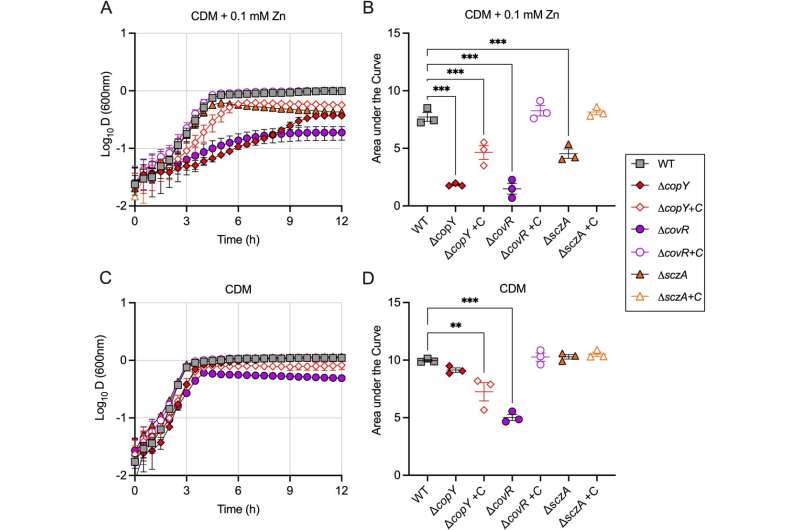Bacteria use genetic switch to defend death by metals

Griffith University researchers have discovered a genetic switch in a common bacterium that helps defend itself against the human body's natural immune system.
Dr. Matthew Sullivan and Dr. Kelvin Goh from the School of Pharmacy and Medical Science at Griffith University have studied how group B streptococcus responds to exposure to the metals zinc and copper and have uncovered a number of ways the bacterium is able to resist metal stress.
"We observed how a genetic switch in group B strep that usually detects and respond to copper, also controls the bacterium's responses to zinc, discovering a neat mechanism of 'cross-talk' in the biological response to these two very different metals,"' Dr. Sullivan said.
"Molecular metals, including copper and zinc, are weaponized by cells of the immune system as highly reactive chemical agents in an ongoing war between host and pathogen, to target and destroy bacteria that should not be there."
"We also found a raft of unknown cellular processes which help contribute to surviving zinc and copper stress in bacteria," said co-author Dr. Kelvin Goh.
"This provides new and fundamental understanding how the pathogen carves a niche for itself in the human body."
The researchers believe research of this type will pave the way for studies that design new strategies to treat bacterial infections without relying on antibiotics—rapidly becoming obsolete due to the continuing rise of antimicrobial resistance.
"Bacteria that cause disease in the human body must defend themselves by resisting the efforts of the human immune system, a potent collection of cells, chemicals and processes that usually does a very good job at keeping invading bacteria (and viruses) out."
The streptococci are a large group of "good" bacteria, such as those found in yogurts, and 'bad' bacteria, that cause nasty and sometimes fatal infections in humans from all age groups.
"Recent Griffith University research focused on one such streptococcal bug, known as group B strep, with a bad reputation for infecting our very youngest (babies) and elderly populations.
"This bacterium usually lives in the gastrointestinal and genital tracts in humans and, most of the time, does not cause harm or make people feel ill.
"However, it can seize an opportunity to cause invasive disease and when it does so, group B strep causes significant problems in elderly or those with comorbidities."
The study has been published in the journal PLOS Pathogens.
More information: Matthew J. Sullivan et al, Regulatory cross-talk supports resistance to Zn intoxication in Streptococcus, PLOS Pathogens (2022). DOI: 10.1371/journal.ppat.1010607
Journal information: PLoS Pathogens
Provided by Griffith University





















